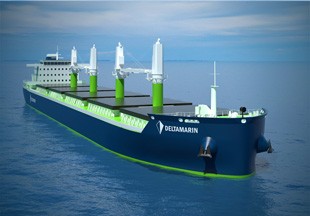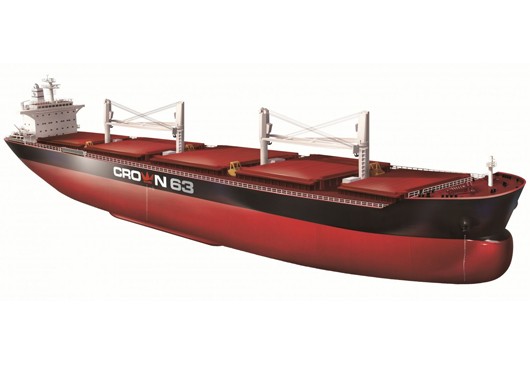UK Strikes at Heart of Russia’s Arctic Energy Empire
New maritime services ban threatens to sever lifeline for Yamal LNG exports By Paul Morgan (gCaptain) – In the frozen waters above the Arctic Circle, a fleet of specialised ships...

There is concern that manufacturers and shipyards might be using environmental terminology to exaggerate the benefits of these ships, and that investing in retrofits may be a better use of money than in buying newbuilds.
Some industry leaders have gone public with their criticism. The CEOs of Danaos, Diana Shipping and Torm have stated that the benefits claimed by eco-ships were “still on paper”, “not …to be in the degree that the yards are trying to present it to be” and “we don’t believe that the ships coming out now are really that different from the ships we’ve received in the same class.”
Confidence in eco-ships is not particularly high.
However, a holistic approach to new ship design is being taken seriously by others. Over the last few years, Chinese and Japanese shipyards in particular have been pioneering the design and construction of eco-ships; with support from classification societies and even some ship owners. Many of these eco-designs incorporate a selection of leading-edge technologies which deliver greater benefits as a package than single measures alone.
This week, Fathom explores several eco-ship design series that are already delivering tangible benefits to shipowners.
Grontmij – Seahorse Series

Danish maritime consultancy, Grontmij has developed a series of fuel-saving bulker designs which have been commercially available for more than two years.
The Seahorse 35 type has been very well received by owners and yards, and is the subject of on-going design optimisation. The tally of ships in service and on order reached 41 by August 2012, including three awarded within the previous month, and involving nine different Chinese yards.
“In 2012, we received four orders on our Seahorse bulk carrier design but in January 2013 we have already received two orders,” stated Leif Jacobsen, Department Director in Grontmij Denmark.
The increase in interest is coming from carriers in Germany and Greece as well as several other places in Europe. Mr Jacobsen points out that a lot of carriers do have the money to invest, but they choose to wait until the right financial moment.
The Seahorse Series comprises of five designs that range between 35,000 and 61,000 dwt. These designs are named the 35, 375, 41, 61 and 62 respectively.
The Seahorse 35 design is a 35,000 DWT handy-size bulk carrier with a slender after-body and high-efficiency New Profile Technology (NPT) propeller that reduces blade surface area and viscous drag. The ship also has a vertical stem design that ensures improved vessel efficiency in challenging weather conditions. In addition, the ship has scope to be fitted with a Mewis Duct to the fore of the propeller.
On the most economical speed setting, Eco II, Grontmij states that the ship can operate at 13 knots at full DWT capacity whilst using only 17 tonnes of fuel per day. This is far below the consumption rate of similar-sized vessels, which is around 27 tonnes of fuel per day based on the assumption of an 8MW engine.
The vessel design also permits operation of the ship on two different grades of HFO and MDO, allowing flexibility for burning varying sulphur content fuels depending on the operating region.
Hyundai Mipo Dockyard – ECO 40 Shallowmax
Hyundai Mipo Dockyard (HMD) is developing a new generation of ECO design MR product/chemical tankers having first received commercial orders for their ECO 40 Shallowmax designs in 2012.
The HMD ECO 40 Shallowmax design has a cubic/shallow-draft combination, with a maximum draft of 10.5 m enabling high efficiency and trade flexibility. The ECO 40 tankers are expected to have an Energy Efficiency Design Index (EEDI) value of 24% lower than the required IMO value for new ships.
D’Amico International Shipping ordered two ECO 40 tankers in July 2012 and followed up with a further order for two more in December 2012. The first vessels are expected to be delivered in 2014
At the time of the order placement, Marco Fiori, CEO of d’Amico International Shipping S.A. commented “these ships are incorporating the latest technologies to optimize speed and fuel consumption, proving our constant effort to offer the most advanced vessels to our customers”.

Deltamarin – B Delta
The Finland-based naval architecture and engineering firm Deltamarin has developed a range of bulker designs and received their first commercial order orders in 2011, a design which has seen considerable success ever since.
The B Delta range currently covers four sizes – the single hull B.Delta25, handysize B.Delta37, Supramax B.Delta64 and Kamsarmax B.Delta82.
All of these vessels allow for increased cargo deadweight and cubic as well as reduced fuel consumption in comparison to the normal equivalent. The expected daily fuel consumption figures are very low: they range from 16.6 tonnes per day at a service speed of 14 knots for the B.Delta25, to 28.8 tonnes per day at a service speed of 14.5 knots for the B.Delta82.
Both the B.Delta 25 and 37 designs have an Energy Efficiency Design Index (EEDI) value that is more than 20% below the IMO minimum requirement for new-build vessels.
As a sign of the commercial attractiveness of this design, forty-two of these ships have currently been ordered from nine different shipowners.
The most recent order for the B.Delta 37 design was placed in December 2012 by China Navigation Pte Ltd (CNCo), for four 38,500 dwt handysize bulk carriers. This follows an order in November 2012 by Oldendorff Carriers GmbH & Co for three open hatch general cargo ships also of the B.Delta 37 design, and a contract with d’Amico Societa di Navigazione S.p.A. in June 2012 for six bulk carriers.
B.Delta has signed contracts with a variety of Chinese Shipyards for construction of their designs including CSIC / Tianjin Xingang, CSSC / Chengxi, Yangfan and CSSC / Guangzhou Wenchong Shipyard Co. Ltd.
HMD also continues to advance its eco-design range. In October 2012, D’Amico ordered an additional two 50,000dwt eco-design product/chemical tankers from HMD. Both vessels will be built to the latest International Maritime Organization (IMO) II Medium Range (MR) design.
According to HMD, these 50,000 dwt eco-ships will meet the Energy Efficiency Design Index (EEDI) Phase 3 requirements for vessels that are scheduled to be built after 1 January 2025, which will use 31.5% less energy than the current IMO reference line.
The vessels are expected to offer average fuel savings of 6-7 tonnes per day compared to the average consumption of the existing MR fleet. This equates to an annual fuel saving of more than $660k based on a bunker price of $650/tonne and 170 operating days a year.
Rolls Royce – Environship
Rolls-Royce has developed the NVC 405 ‘Environship’ concept for container and RoRo vessels. This design received its first commercial order in October 2011.
The Environship design draws on a range of Roll-Royce’s fuel-saving technologies. The design features a wave piercing bow which adds hydrodynamic assistance in addition to the company’s signature Bergen LNG gas engines and the Promas integrated rudder and propulsion system.
The company claims that this vessel design can increase fuel efficiency by 18% although no baseline for comparison to the figure is given. The 18% total efficiency reduction is comprised of a 5-8% saving from the Promas system alone and an 8% resistance reduction from the hydrodynamic shape of the bow.
In November 2012, Rolls Royce announced a joint venture with Italian ferry operator Lauro Shipping to develop gas-powered ferries based on the Environship concept. This important agreement marked the first time that a customer will utilise the Environship concept for a passenger vessel, after previous orders for cargo ships.
Neil Gilliver, President of Merchant division at Rolls Royce, said “This latest development for our Environship concept is proof that there’s a genuine desire from ship owners to embrace cutting edge marine technology to reduce environmental impact. We look forward to working with Lauro Shipping on this exciting project, which could be the first gas powered ferry operating in the Mediterranean.”
SinoPacific – Crown Bulker Designs

The Sinopacific Shipbuilding Group has developed what they claim to be a fuel-efficient and environmentally friendly series of bulker designs, the first of which was delivered in early 2012.
The designs in this series are the CROWN 63, 82 and 121 – designed for the 60,000 dwt, 80,000 dwt, and 120,000 dwt bulk carrier markets respectively.
The CROWN 63 Supramax bulkers were the first to be delivered in this range. They are fitted with a Nakashima large diameter propeller and an electric engine as well as receiving innovations in optimizing the ship hull lines. According to SinoPacific, this allows the CROWN 63 to provide 9% more deadweight tonnage and 13% less fuel consumption than its predecessor the CROWN 58. Tests conducted by Bureau Veritas are said to have confirmed this level of reduction.
Sinopacific is also in the process of extending the CROWN eco-bulker range. The CROWN MHI 82 has been developed in partnership with Mitsubishi Heavy Industries (MHI) and will incorporate energy-saving devices and propellers manufactured by MHI for optimum propulsion efficiency.
Dr. Zhao Ye, Chief Technology Officer of SINOPACIFIC, comments: “The goal of a joint optimized design with MHI is to further reduce the fuel consumption of the ship, and we’re expecting to reach a level of less than 28 tons per day.”
The CROWN 121 Mini-Cape bulk carrier is another in the CROWN series which is designed with a V-bow and MAN G-type main engine. Sinopacific claims that this vessel achieves fuel savings of up to 23% compared to its predecessor, the CROWN 118. The company claims that the CROWN 121 has a daily consumption rate of 38 tonnes compared with 49.1 tonnes for the CROWN 118.
The first CROWN 63 was delivered for the shipowner Turner. This ship was the first to obtain a global EEDI (Energy Efficiency Design Index) certificate issued by Bureau Veritas.
“Crown 63 is reaching all goals of consumption reduction as expected by design.” states GREENSHIP Singapore, who has already confirmed orders of four sister ships. “The friendly design of Crown 63 is in conformity with the environmental protection policies of Singapore. Based on the attained EEDI stage 2 value of the ship, it has achieved a reduction factor of up to 20% making it eligible to a serious reduction in Initial Registration Fees as well as Annual Tonnage Tax rebates till 31 Dec 2019.”
Conclusion
The design and uptake of eco-ship designs continues apace. The increasing volume of orders suggests that this trend is set to increase rather than fade, and the level of indicated fuel savings suggests that these vessels will become increasingly more attractive as an investment. Beneath the hype around eco-ships, there are some weighty contenders for new ship designs that are worth serious consideration.

Sign up for gCaptain’s newsletter and never miss an update

Subscribe to gCaptain Daily and stay informed with the latest global maritime and offshore news
Essential news coupled with the finest maritime content sourced from across the globe.
Sign Up